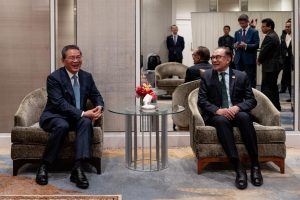The Diplomat author Mercy Kuo regularly engages subject-matter experts, policy practitioners, and strategic thinkers across the globe for their diverse insights into U.S. Asia policy. This conversation with Dr. Chow-Bing Ngeow – professor in the Faculty of Arts and Social Sciences and director of the Institute of China Studies at the Universiti Malaya in Kuala Lumpur– is the 424th in “The Trans-Pacific View Insight Series.”
Identify the top three outcomes of Chinese Premier Li Qiang’s June visit to Malaysia.
The first notable outcome is the Joint Statement between Malaysia and China. The last time both countries issued a Joint Statement was 2018. Compared to the 2018 Joint Statement, the 2024 Joint Statement is a much more upbeat document, with many phrases that will please the Chinese side, including the support for China’s position on the Taiwan issue, and the recommitment to engage in bilateral discussions on maritime affairs.
The second outcome is the list of 14 bilateral government-to-government MOUs [memoranda of understanding] between different ministries or government bodies, with the Five-Year Economic and Trade Program being the most important one. These MOUs and agreements reinforce the steady increase in bilateral cooperation in various functional and cultural areas.
The third outcome is the personal meeting between Li Qiang and [Malaysian Prime Minister] Anwar. This is at least the third time Anwar and Li Qiang interacted at the personal level, and the rapport between the two leaders seemed to be building up quite well.
What is the impact of Chinese President Xi Jinping’s decision to send Li to Malaysia on Prime Minister Anwar Ibrahim’s pro-China strategy?
Malaysia certainly wished that Xi Jinping would visit, but the overall impact of Xi’s non-visit on Malaysia’s China policy should not be exaggerated. The bilateral ties are now quite steady, stable, and positive, while Li’s visit was also very well received. It is still possible that Xi will visit in 2025, and both countries are working on this.
Analyze how Malaysia has benefitted, if at all, from China’s Belt and Road Initiative.
The two main Belt and Road Initiative projects in Malaysia are the East Coast Rail Link (ECRL) and the Malaysia-China Kuantan Industrial Park. The former is still being constructed and will be completed perhaps in 2026. The terms of the ECRL project were renegotiated twice since 2018, with increased commitment from China to benefit the local businesses. China’s SOE [state-owned enterprise] is the main contractor but there are also quite a number of local partners. Once completed, the ECRL could enhance the connectivity between the east and west coasts of Peninsular Malaysia.
As for the Malaysia-China Kuantan Industrial Park, it has increased its size a couple of times, due to increased investments and projects within the park. The park is adjacent to the Kuantan Port, which also has received Chinese investment to upgrade its capacity. Overall, these projects have increased investments and have brought economic opportunities.
Both these projects started during the administration of Prime Minister Najib Abdul Razak (2009-2018), so there are no new signature major infrastructure projects that have materialized since 2018, despite the overall supportive stance of Malaysia towards the Belt and Road Initiative. However, the reason for this lack of new projects is not necessary political/geopolitical. Both governments have their own fiscal considerations at this moment and are not ready to commit to major infrastructure projects.
But smaller scale cooperation projects could still take place, under the Belt and Road umbrella. There is Belt and Road Cooperation Plan that is under negotiation and will be signed in the second half of the year.
Examine Kuala Lumpur’s geopolitical calculus in advancing Malaysia’s interest amid China-U.S. strategic competition in Southeast Asia.
To a certain extent, Malaysia benefits from the U.S.-China strategic competition, particularly in the economic sphere, as many investments, especially in technology-related fields, have come to Malaysia. This is a strategic opportunity that Malaysia aims to leverage at for its own industrial and technological upgrading. However, Malaysia is also aware that the more intense the competition becomes, the more difficult or untenable it would be for Malaysia to continue to benefit from the strategic competition.
Assess perceptions of Malaysia’s political elites and public toward U.S. leadership in Southeast Asia vis-à-vis China’s growing regional influence.
The perception towards the U.S. is certainly affected by the Gaza war. Ideologically speaking, Anwar, together with many political elite in Malaysia, generally have certain affinities with the solidarity and collective struggle of countries in the developing world (Global South) and with the ideas of pan-Asianism, and sometimes this kind of affinities could contain sentiments critical of the U.S. and the West in general.
But it should be noted that Anwar has continued to emphasize that Malaysia values its partnership and friendship with the U.S. despite their huge differences on the Palestine issue. Malaysia continues to maintain a robust security partnership with the U.S., Australia, and other Western countries. The constructive presence of the U.S. in Southeast Asia is certainly appreciated, albeit quietly.

































